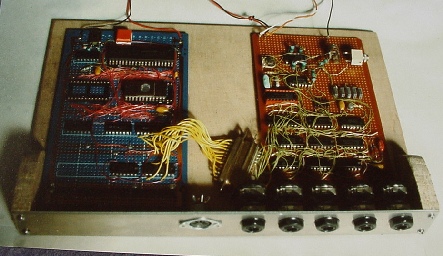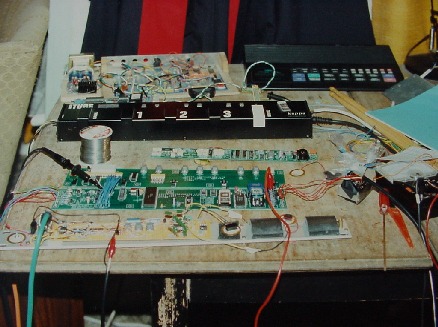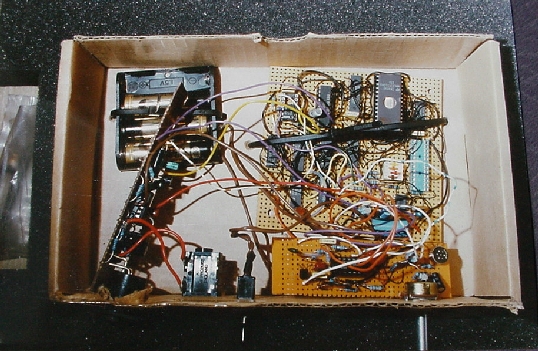Mixerton Midi Triggering Devices
|
Over the years, I have worked on a large number of MIDI-related projects. I put a few on this page. C-Ducer Drum Wizard.
 The C-Ducer Drum Wizard was introduced in 1988 by the Audio Marketing Group. It was a 19 inch rack mount device that would accept input from up to eight C-Ducer contact microphones. It provided two outputs: a stereo pair mixed using the the front panel level and pan controls, and a velocity-sensitive MIDI output, where the threshold for each channel was set using the upper control. Review article by Norman Weinberg: PDF.
 The C-Ducer contact microphone is a flexible, self-adhesive unit that gives a life-like sound from the body of an instrument. I implemented the prototype MIDI trigger for the Drum Wizard, using two circuit cards on a wooden base. It used a Z80 whereas the production unit used a 6803 owing to its onboard UART for the MIDI input and output. Only five channels were provided on the prototype.  Kappa Instruments MidiTube Another MIDI trigger, the MidiTube was a wearable musical instrument for percussionists who want to dance around the stage rather than be stuck behind the kit. It was painted with xtra-white paint so that it really glowed, although the pictured prototype is naked. A large number of different MidiTubes were created. The largest was over six-foot long and could be tapped in various places or banged on the stage. Peter Gabriel's drummer used one of the large prototypes for the Nelson Mandela concert.  In this picture, taken during development, one of the floor units can be seen. The tube connected to the floor unit where a number of pedals and buttons could be used to change programmes and parameters.  A fully integrated incarnation of the MidiTube was implemented using a large membrane panel containing the touch pads and the controls. These touch pads were pressure senstivie and so could be used as MIDI continuous controllers as well as note triggers. A development of this one was used in a theme park, where children pressed on the pannels or broke IR light-beams with their fingers. Mixerton KickMate The Mixerton KickMate was designed as a direct replacement for the microphone placed inside the kick drum for rock groups in small venues. Playing on wooden floors, the kick drum often sounds much weaker than the sound used on commercial records played before and after the band. This unit contained four drum samples in the EPROM which are played out through the XLR connector when triggered by the built-in electret microphone. The idea was that the kickmate would be housed in a case resembling a conventional microphone. For production, using surface mount (which was new to the mainstream in those days) I achieved a PCB size of 5 square inches. Pictured is the prototype, housed only in a cardboard box, but it did survive a number of trial sessions at the Boat Race Pub in Cambridge. The front panel, from left to right, is XLR output, 1/4 inch output, on/off, and sensitivity. The re-trigger mode and the sample to play were selected with the DIL switches on the digital card. The device was velocity sensitive, using modulation of the (12-bit) DAC voltage reference as the gain mechanism. (C) DJ Greaves. 1985-90. |